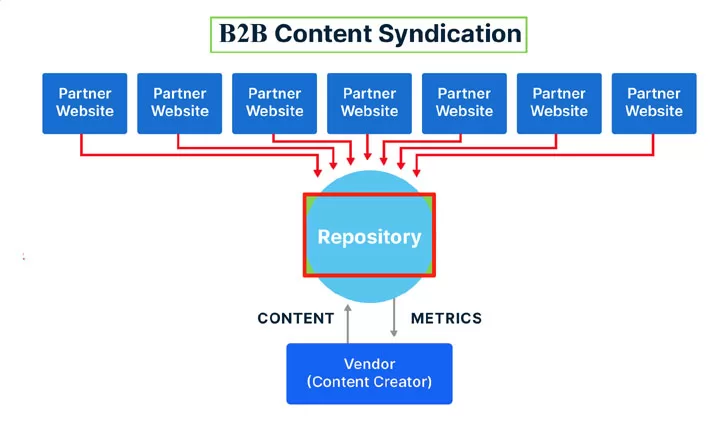How to Get Started with B2B Content Syndication
Now that we’ve explored the benefits of B2B content syndication, let’s delve into the practical steps for getting started with this powerful marketing strategy.
Define Your Objectives and Target Audience
- Set Clear Goals: Begin by defining your objectives. Are you looking to generate leads, establish thought leadership, or increase brand visibility? Having specific goals will guide your syndication efforts.
- Know Your Audience: Understand your target B2B audience inside and out. What are their pain points, challenges, and preferences? Tailor your content to address their needs and interests.
Create High-Quality, Relevant Content
- Content is Key: Content is the heart of syndication. Produce high-quality, informative, and engaging content that resonates with your target audience. Consider various formats, such as articles, whitepapers, infographics, or videos.
- Optimize for SEO: Ensure your content is optimized for search engines with relevant keywords, meta descriptions, and SEO best practices. This helps improve its discoverability.
Choose the Right Syndication Partners
- Research Syndication Platforms: Identify reputable B2B content syndication platforms or services that cater to your industry or niche. Research their reach, audience demographics, and credibility.
- Evaluate Partnerships: Carefully assess potential syndication partners. Look for platforms that align with your goals and target audience. A good partner should have a network of websites and publications that can effectively distribute your content.
Craft a Distribution Strategy
- Content Selection: Decide which pieces of content you want to syndicate. Start with your most valuable and informative pieces that align with your goals.
- Frequency: Determine how often you’ll syndicate content. Consistency is key, but also consider the capacity of your content production team.
- Scheduling: Plan a content syndication schedule that aligns with your audience’s online behavior and preferences. Timing can affect the visibility of your content.
Measuring and Analyzing Syndication Success
- Set Metrics: Establish key performance indicators (KPIs) to measure the success of your syndication efforts. These may include website traffic, click-through rates, lead generation, and conversion rates.
- Analytics Tools: Utilize analytics tools to track and analyze the performance of your syndicated content. Regularly review the data to make data-driven adjustments to your strategy.
Engage with Your Syndication Audience
- Respond to Comments: If your syndicated content generates comments or inquiries, engage with your audience promptly. Address questions and feedback to build relationships.
- Encourage Sharing: Encourage readers to share your content on social media or other platforms, further expanding its reach.
Continuously Optimize Your Strategy
- Iterate and Improve: B2B content syndication is not a one-time effort. Continuously refine your strategy based on the performance data and feedback you gather. Adapt to changes in your industry and audience preferences.
Stay Compliant with the Guidelines
- Respect Syndication Guidelines: Ensure that you follow the guidelines and terms set by your syndication partners and platforms to maintain a positive relationship.
By following these steps and remaining committed to delivering valuable content to your B2B audience, you can effectively kickstart your B2B content syndication strategy and harness its potential for business growth.
Best Practices for Successful B2B Content Syndication
To maximize the benefits of B2B content syndication, it’s essential to implement best practices that ensure your strategy is effective and yields the desired results. Here are some best practices to consider:
Consistency in Content Production
- Regularly Publish Quality Content: Consistency is key. Maintain a steady schedule for producing and syndicating content. This not only keeps your audience engaged but also demonstrates your commitment to providing valuable insights.
- Content Calendar: Create a content calendar to plan and organize your syndication efforts. This helps you stay on track and ensures a balanced mix of content types.
Optimal Content Formatting for Syndication
- Adapt Content for Different Platforms: Tailor your content to fit the format and style of the platforms where it will be syndicated. Ensure it looks and reads well on various websites and publications.
- Mobile Optimization: With a growing number of users accessing content on mobile devices, make sure your syndicated content is mobile-friendly and responsive.
Leveraging Various Content Types
- Diversify Your Content: Explore different content formats, such as articles, whitepapers, videos, and infographics. Different audiences prefer different types of content, so catering to various preferences can broaden your reach.
- Repurpose Content: Repurpose and update existing content to reach new audiences. For example, turn a popular blog post into a video or a downloadable eBook.
Engaging with Your Syndication Audience
- Engage in Conversations: Respond promptly to comments and inquiries on your syndicated content. Engaging with readers fosters a sense of community and encourages interaction.
- Encourage Feedback: Encourage readers to provide feedback or share their thoughts on the content. Use this input to improve your future content.
Monitor and Optimize Performance
- Track Key Metrics: Regularly monitor key performance metrics such as website traffic, click-through rates, conversion rates, and the number of leads generated from syndication efforts.
- A/B Testing: Conduct A/B tests to optimize elements like headlines, call-to-action buttons, and content formats to improve performance over time.
Build and Nurture Relationships
- Network with Partners: Maintain positive relationships with your syndication partners. Collaborate with them on content ideas and initiatives that benefit both parties.
- Engage in Industry Communities: Join and participate in industry forums, groups, and online communities to connect with like-minded professionals. Share your syndicated content when relevant.
Stay Updated with Industry Trends
- Stay Informed: Keep abreast of industry trends, changes in content consumption habits, and emerging technologies that can impact your syndication strategy.
Measure ROI and Adjust Strategies
- Calculate ROI: Evaluate the return on investment (ROI) for your syndication efforts. Measure the cost of syndication against the leads and revenue generated. Adjust your strategy if needed.
- Data-Driven Decisions: Base your decisions on data and analytics. If certain content types or platforms consistently outperform others, allocate more resources accordingly.
Stay Compliant with Syndication Agreements
- Adhere to Agreements: Ensure that you follow the guidelines and agreements set by your syndication partners and platforms. Violating these terms can harm your reputation and partnerships.
By following these best practices, you can create a sustainable and effective B2B content syndication strategy that not only boosts your brand’s visibility but also generates high-quality leads and establishes your business as an industry authority. Remember that continuous improvement and adaptation to changing trends are key to long-term success in content syndication.
Real-World Examples of B2B Content Syndication Success Stories
To illustrate the effectiveness of B2B content syndication, let’s explore some real-world examples of businesses that have leveraged this strategy to achieve significant success:
1. HubSpot:

- Content Hub and Syndication: HubSpot, a leading inbound marketing and sales software company, operates a content hub where they publish a wide range of informative and educational content. They syndicate this content to various industry publications and partner websites.
- Success Metrics: HubSpot’s content syndication strategy has contributed to a substantial increase in organic traffic, lead generation, and brand recognition. They’ve also seen their content syndicated on authoritative platforms like Forbes and Entrepreneur, enhancing their credibility.
2. Salesforce:

- Thought Leadership Content: Salesforce, a global customer relationship management (CRM) platform, consistently produces thought leadership content related to sales, marketing, and customer service. They syndicate this content to industry-specific publications and partner networks.
- Success Metrics: Salesforce’s syndication efforts have helped them establish themselves as thought leaders in the CRM and cloud computing space. Their content is widely shared and discussed, leading to increased brand authority and lead generation.
3. Marketo (Adobe):

- Multi-Format Syndication: Marketo, a marketing automation software company now part of Adobe, creates a variety of content formats, including blogs, webinars, and eBooks. They syndicate this content through partner networks and industry publications.
- Success Metrics: Marketo’s content syndication strategy has resulted in improved lead quality, shorter sales cycles, and higher conversion rates. Their content often reaches decision-makers in the marketing and sales fields.
4. Oracle:

- Targeted Industry Syndication: Oracle, a global technology company, produces content that addresses specific industry challenges and trends. They syndicate this content to industry-specific websites, blogs, and forums.
- Success Metrics: Oracle’s targeted syndication strategy has led to increased engagement with industry professionals, improved brand recognition, and deeper relationships with customers in various sectors, such as finance and healthcare.
5. IBM:

- Educational Content: IBM, a multinational technology company, focuses on creating educational content that helps businesses understand and navigate complex technologies. They syndicate this content through industry publications and technology forums.
- Success Metrics: IBM’s content syndication efforts have positioned them as a trusted resource for businesses seeking technological solutions. Their content syndication strategy has contributed to lead generation and business growth.
These real-world examples demonstrate how B2B content syndication can be a valuable tool for businesses of all sizes and industries. By consistently producing high-quality, relevant content and strategically syndicating it to the right partners and platforms, these companies have not only increased brand visibility but also generated leads and established themselves as industry authorities. B2B content syndication can be a powerful addition to your marketing arsenal when executed effectively.
Potential Challenges and How to Overcome Them in B2B Content Syndication
While B2B content syndication can be highly beneficial, it’s important to be aware of potential challenges that may arise and have strategies in place to address them effectively:
1. Content Quality Control:
- Challenge: Maintaining consistent quality across syndicated content can be challenging, especially when content is republished on multiple platforms.
- Solution: Implement strict editorial guidelines and review processes to ensure that syndicated content aligns with your brand’s standards. Regularly audit content on syndication platforms to identify and correct any discrepancies.
2. Partner Selection:
- Challenge: Choosing the right syndication partners who align with your industry and target audience can be difficult.
- Solution: Conduct thorough research to identify reputable partners. Evaluate their audience reach, engagement levels, and the quality of their content. Start with a small pilot program to test the effectiveness of the partnership before committing to a long-term agreement.
3. Duplicate Content Issues:
- Challenge: Syndicating content across multiple websites can potentially lead to duplicate content issues, which can affect search engine rankings.
- Solution: Implement canonical tags on syndicated content to indicate the original source on your website. This informs search engines which version of the content should be indexed, mitigating the risk of duplicate content penalties.
4. Content Customization:
- Challenge: Different syndication platforms may have specific formatting requirements or limitations, making it challenging to present content consistently.
- Solution: Customize content for each syndication platform while maintaining core messaging and branding. Adapt headlines, introductions, and visuals to suit the style and format of the specific platform.
5. Tracking and Measurement:
- Challenge: Accurately tracking the performance of syndicated content and attributing leads to specific syndication efforts can be complex.
- Solution: Implement tracking parameters (UTM parameters) in your syndicated URLs to trace the source of traffic and conversions. Utilize analytics tools that allow you to segment and analyze syndication-generated traffic and leads.
6. Maintaining Control of Brand Messaging:
- Challenge: As content is syndicated on external platforms, there is a risk that the messaging may be slightly altered or taken out of context.
- Solution: Clearly communicate your brand’s guidelines and messaging standards to syndication partners. Regularly review syndicated content to ensure it aligns with your intended messaging.
7. Content Overexposure:
- Challenge: Overexposure of content on multiple platforms can lead to diminishing returns as the same audience sees the content repeatedly.
- Solution: Manage content distribution carefully to avoid saturating the same audience. Rotate the content you syndicate and focus on creating fresh, unique pieces for syndication.
8. Measuring ROI:
- Challenge: Determining the return on investment (ROI) of your syndication efforts can be challenging due to varying conversion paths and attribution complexities.
- Solution: Use advanced attribution models and analytics tools to track leads and conversions across multiple touchpoints. Assign values to leads based on their source and behavior to better assess the impact of syndication.
By proactively addressing these challenges and implementing the suggested solutions, businesses can navigate the complexities of B2B content syndication and maximize its benefits while minimizing potential drawbacks. A well-thought-out syndication strategy, coupled with effective management and measurement, can help overcome these challenges and drive success in your content syndication efforts.
Conclusion
In the fast-paced world of B2B marketing, where competition is fierce and attention spans are limited, B2B content syndication emerges as a strategic powerhouse. This marketing approach, which involves sharing your valuable content with other businesses and industry publications, offers a multitude of benefits that can propel your business to new heights.
From enhanced brand visibility and credibility to a steady stream of high-quality leads, B2B content syndication has proven its worth time and again. It positions your business as a thought leader, fosters industry relationships, and supports sales and revenue growth. Through real-world examples, we’ve seen how leading companies have harnessed this strategy to achieve remarkable success.
Getting started with B2B content syndication requires a well-defined plan. You must set clear objectives, create quality content, choose the right syndication partners, and develop a distribution strategy. Along the way, measuring and optimizing your efforts are critical for continued success.
Remember the best practices we’ve discussed: consistency in content production, optimal content formatting, leveraging various content types, engaging with your audience, monitoring and optimizing performance, building and nurturing relationships, staying informed about industry trends, and staying compliant with syndication agreements.
However, B2B content syndication isn’t without its challenges. From maintaining content quality to tracking ROI, each hurdle can be surmounted with careful planning and execution. By addressing these challenges head-on, you can ensure that your syndication efforts are not only effective but also sustainable.
In conclusion, B2B content syndication is a dynamic strategy that can strategically boost your business. It allows you to reach a wider audience, build authority in your industry, and generate leads from businesses genuinely interested in your offerings. By following the principles and best practices outlined in this guide, you can harness the full potential of B2B content syndication and drive your business toward greater success in the ever-evolving landscape of digital marketing. So, take the first step, and let the power of syndication propel your business forward.
Don’t forget to Subscribe to our newsletter to stay updated about Digital Marketing and Search Engine Optimizations.


